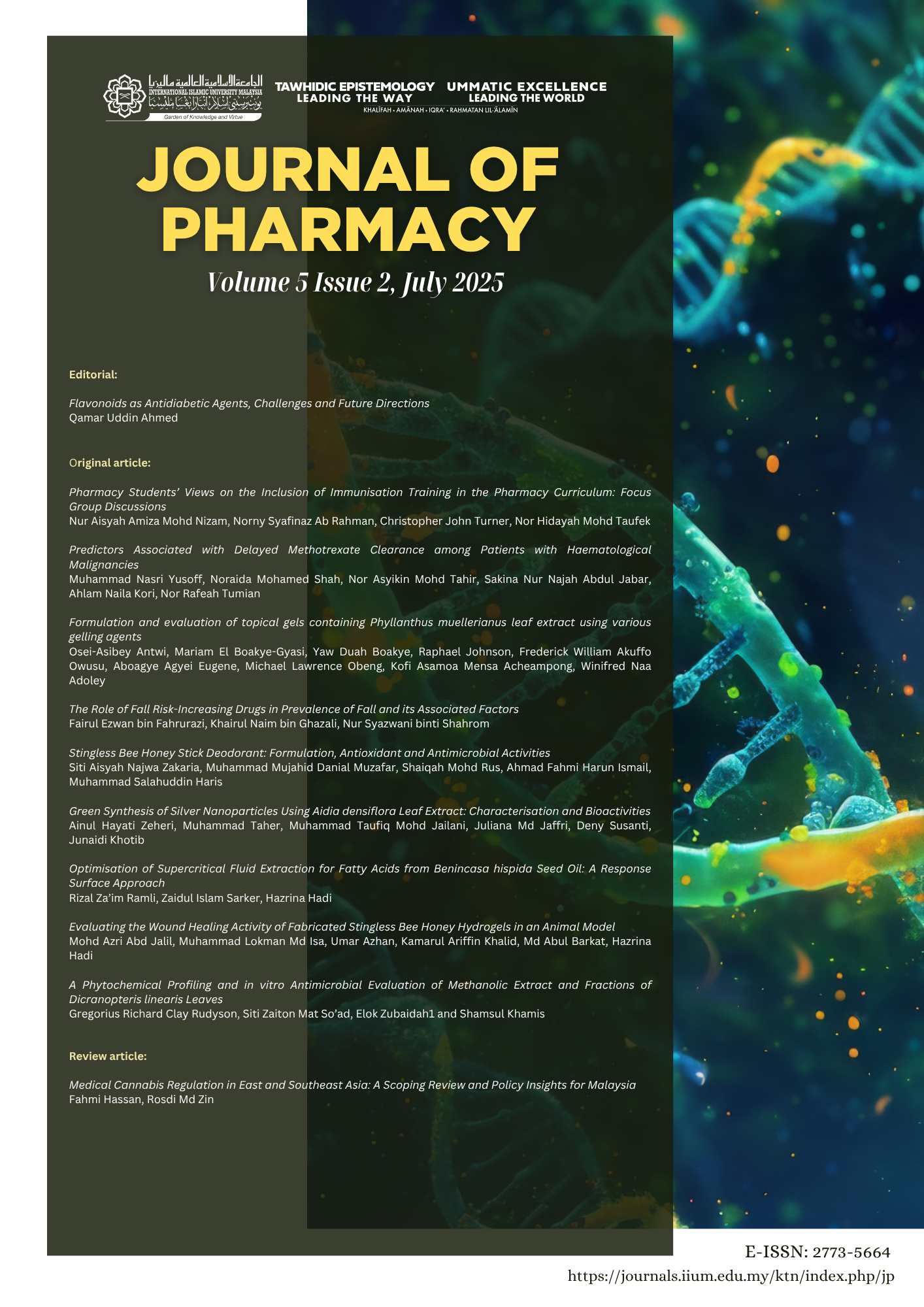Flavonoids as Antidiabetic Agents, Challenges and Future Directions
Main Article Content
Abstract
Diabetes is a global health concern, affecting hundreds of millions of people worldwide. The number of adults living with diabetes has risen dramatically, from approximately 200 million in 1990 to nearly 589 million in 2024. Type 2 diabetes (T2DM) accounts for 90% of all cases. The incidence is increasing more rapidly in low- and middle-income countries than in high-income countries. By 2050, the number of people with diabetes is likely to reach over 853 million. Diabetes was the ninth leading cause of death globally in 2020, contributing to over 2 million deaths annually. In 2021, diabetes and kidney disease due to diabetes were responsible for more than 2 million deaths, and approximately 11% of cardiovascular deaths were associated with high blood glucose (International Diabetes Federation, 2025).
Article Details

This work is licensed under a Creative Commons Attribution 4.0 International License.
Journal of Pharmacy at https://journals.iium.edu.my/ktn/index.php/jp is licensed under a Creative Commons Attribution 4.0 International License.
References
Ahmed, Q.U., Ali, A.H.M., Mukhtar, S., Alsharif, M.A., Parveen, H., Sabere, A.S. M., Nawi, M.S. Mohd., Khatib, A., Siddiqui, M.J., Umar, A., & Alhassan, A.M. (2020). Medicinal potential of isoflavonoids: Polyphenols that may cure diabetes. Molecules, 25(23), 5491. https://doi.org/10.3390/molecules25235491
Al-Ishaq, R.K., Abotaleb. M., Kubatka, P., Kajo, K., & Büsselberg, D. (2019). Flavonoids and their antidiabetic effects: Cellular mechanisms and effects to improve blood sugar levels. Biomolecules, 9(9), 430. https://doi.org/10.3390/biom9090430
Anbualakan, K., Tajul Urus, N.Q., Makpol, S., Jamil, A., Mohd Ramli, E.S., Md Pauzi, S.H., & Muhammad, N. (2023). A scoping review on the effects of carotenoids and flavonoids on skin damage due to ultraviolet radiation. Nutrients, 15(1), 92. https://doi.org/10.3390/nu15010092
Ansari, P., Choudhury, S.T., Seidel, V., Rahman, A.B., Aziz, Md. A., Richi, A.E., Rahman, A., Jafrin, U.H., Hannan, J.M.A., & Abdel-Wahab, Y.H.A. (2022). Therapeutic potential of quercetin in the management of type-2 diabetes mellitus. Life, 12(8), 1146. https://doi.org/10.3390/life12081146
Caro-Ordieres, T., Marín-Royo, G., Opazo-Ríos, L., Jiménez-Castilla, L., Moreno, J. A., Gómez-Guerrero, C., & Egido, J. (2020). The coming age of flavonoids in the treatment of diabetic complications. Journal of Clinical Medicine, 9(2), 346. https://doi.org/10.3390/jcm9020346
Dhanya, R., & Kartha, C.C. (2021). Quercetin improves oxidative stress-induced pancreatic beta cell alterations via MTOR-signaling. Molecular and Cellular Biochemistry, 476(11), 3879-3887. https://doi.org/10.1007/s11010-021-04193-3
Dhanya, R., Arya, A.D., Nisha, P., & Jayamurthy, P. (2017). Quercetin, a lead compound against type 2 diabetes ameliorates glucose uptake via AMPK pathway in skeletal muscle cell line. Frontiers in Pharmacology, 8, 336. https://doi.org/10.3389/fphar.2017.00336
Davies, N.M., & Yáñez, J.A. (2012). Flavonoid pharmacokinetics: Methods of analysis, preclinical and clinical pharmacokinetics, safety, and toxicology. Publisher: John Wiley & Sons, - Science - 352 pages. https://doi.org/ 10.1002/9781118468524
Fan, Z.F., Ho, S.T., Wen, R., Fu, Y., Zhang, L., Wang, J., Hu, C., Shaw, P.C., Liu, Y., & Cheng, M.S. (2019). Design, synthesis and molecular docking analysis of flavonoid derivatives as potential telomerase inhibitors. Molecules, 24(17), 3180. https://doi.org/10.3390/molecules24173180
Günal?Köro?lu, D., Catalkaya, G., Yusufo?lu, B., Kezer, G., Esatbeyoglu, T., Abd El?Aty, A. M., & Capanoglu, E. (2025). Quercetin: Potential antidiabetic effects through enzyme inhibition and starch digestibility. Food Safety and Health, 3(1), 9-22. https://doi.org/10.1002/fsh3.12066
Hu, L., Luo, Y., Yang, J., & Cheng, C. (2025). Botanical flavonoids: Efficacy, absorption, metabolism and advanced pharmaceutical technology for improving bioavailability. Molecules, 30(5), 1184. https://doi.org/10.3390/molecules30051184
International Diabetes Federation (2025). Diabetes global report 2000-2050. https://diabetesatlas.org/data-by-location/global/
Ke, R.Q., Wang, Y., Hong, S.H., & Xiao, L.X. (2023). Anti-diabetic effect of quercetin in type 2 diabetes mellitus by regulating the microRNA-92b-3p/EGR1 axis. Journal of Physiology and Pharmacology, 74(2). https://doi.org/ 10.26402/jpp.2023.2.03
Koz?owska, A. (2025). Clinical insights into non-alcoholic fatty liver disease and the therapeutic potential of flavonoids: An update. Nutrients, 17(6), 956. https://doi.org/10.3390/nu17060956
Lai, D., Huang, M., Zhao, L., Tian, Y., Li, Y., Liu, D., Wu, Y., & Deng, F. (2019). Delphinidin induced autophagy protects pancreatic ? cells against apoptosis resulting from high-glucose stress via AMPK signaling pathway. Acta Biochimica et Biophysica Sinica, 51(12), 1242-1249. https://doi.org/10.1093/abbs/gmz126
Martín, M.Á., & Ramos, S. (2021). Impact of dietary flavanols on microbiota, immunity and inflammation in metabolic diseases. Nutrients, 13(3), 850. https://doi.org/10.3390/nu13030850
Nur Farisya, S., Ahmed Q.U., Mahmood S., Shah S.A.A., Khatib A., Mukhtar S., Alsharif M.A., Parveen H., & Zakaria Z.A. (2022). Antibacterial effects of flavonoids and their structure-activity relationship study: A comparative interpretation. Molecules, 27(4), art. no. 1149. https://doi.org/10.3390/molecules27041149
Qian, J., Guo, Y., Xu, Y., Wang, X., Chen, J., & Wu X. (2023). Combination of micelles and liposomes as a promising drug delivery system: a review. Drug Delivery and Translational Research, 13(11), 2767-2789. https://doi.org/10.1007/s13346-023-01394-9
Shamsudin, N.F., Ahmed, Q.U., Mahmood, S., Shah, S.A.A., Sarian, M.N., Khattak, M.M.A.K., Khatib, A., Sabere, A.S.M., Yusoff, Y.M., & Latip, J. (2022). Flavonoids as antidiabetic and anti-inflammatory agents: A review on structural activity relationship-based studies and meta-analysis. International Journal of Molecular Sciences, 23(20), 12605. https://doi.org/10.3390/ijms232012605.
Spínola, V., Llorent-Martínez, E. J., & Castilho, P. C. (2020). Inhibition of ?-amylase, ?-glucosidase and pancreatic lipase by phenolic compounds of Rumex maderensis (Madeira sorrel). Influence of simulated gastrointestinal digestion on hyperglycaemia-related damage linked with aldose reductase activity and protein glycation. Lwt, 118, 108727. https://doi.org/10.1016/j.lwt.2019.108727
Stevens Barrón, J.C., Chapa González, C., Álvarez Parrilla, E., & De la Rosa, L.A. (2023). Nanoparticle-mediated delivery of flavonoids: Impact on proinflammatory cytokine production: A systematic review. Biomolecules, 13(7), 1158. https://doi.org/10.3390/biom13071158
Wang, Y., Chen, J., He, G., Yin, L., & Liao, Y. (2025). Unlocking the potential of flavonoid biosynthesis through integrated metabolic engineering. Frontiers in Plant Science, 16, 1597007. https://doi.org/10.3389/fpls.2025.1597007
Yang, Y., Chen, Z., Zhao, X., Xie, H., Du, L., Gao, H., & Xie, C. (2022). Mechanisms of Kaempferol in the treatment of diabetes: A comprehensive and latest review. Frontiers in Endocrinology, 13, 990299. https://doi.org/10.3389/fendo.2022.990299




